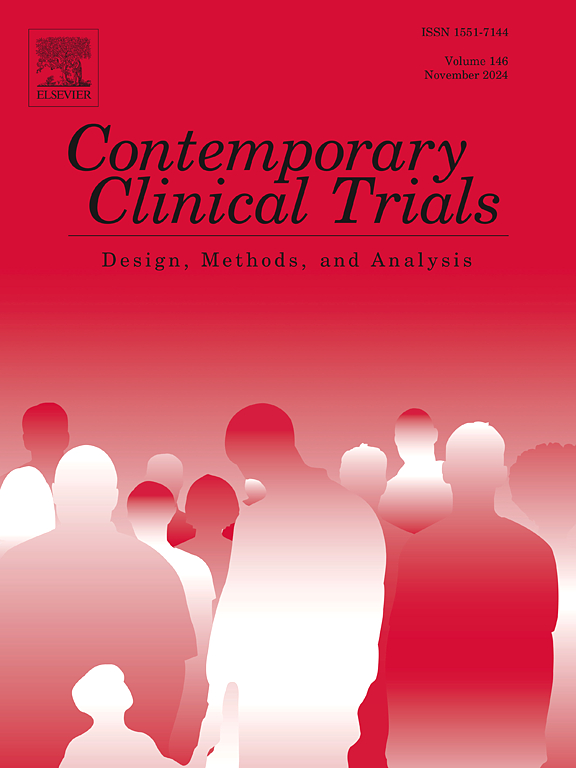Restricted mean survival time based on Wu-Kolassa estimator compared to Kaplan-Meier estimator
IF 2
3区 医学
Q3 MEDICINE, RESEARCH & EXPERIMENTAL
引用次数: 0
Abstract
Objective
The purpose of the paper is to introduce the Wu-Kolassa estimator (WKE) and the RMST based on it for its less biased estimation and substantial power gain, compared to the Kaplan-Meier estimator (KME), to researchers working in medical and health sciences to evaluate and compare patient survival times.
Results
The seven numerical studies showed that the power gain in WKE-based RMST analysis can reach more than 80 %, depending on the size of the study and the trend of failure rate. For the phase III study of iniparib plus gemcitabine and carboplatin (GCI) versus gemcitabine and carboplatin (GC) in patients with metastatic triple-negative breast cancer, GCI is superior to GC demonstrated by WKE-based RMST analysis (point estimate of treatment difference in RMST = 0.807; 95 % CI: 0.0214 to 1.592, 1.5 times higher than the estimate based on KME = 0.542; 95 % CI: −0.385 to 1.470). For the phase III trial that studied ovarian suppression (os) with tamoxifen or exemestane, tamoxifen plus os is superior to tamoxifen alone using WKE-based RMST (point estimate of difference = 0.228; 95 % CI: 0.016 to 0.439, more than 2-fold higher than the estimated difference based on KME = 0.113; 95 % CI: −0.008 to 0.234).
Conclusions
The Wu-Kolassa estimator is superior to the Kaplan-Meier estimator as it reduces the estimation bias and increases the power in the RMST analysis when the censoring rate is high or when the reference group has more censoring data than the test group.
基于Wu-Kolassa估计的受限平均生存时间与Kaplan-Meier估计的比较
目的介绍Wu-Kolassa估计器(WKE)和基于它的RMST,与Kaplan-Meier估计器(KME)相比,它的估计偏差更小,功率增益更大,用于医学和健康科学的研究人员评估和比较患者的生存时间。结果7项数值研究表明,根据研究规模和故障率趋势的不同,基于wke的RMST分析的功率增益可达到80%以上。对于iniparib +吉西他滨和卡铂(GCI)与吉西他滨和卡铂(GC)治疗转移性三阴性乳腺癌患者的III期研究,基于wkermst分析显示,GCI优于GC (RMST治疗差异点估计= 0.807;95% CI: 0.0214 ~ 1.592,比基于KME = 0.542的估计值高1.5倍;95% CI:−0.385 ~ 1.470)。在研究他莫昔芬或依西美坦卵巢抑制(os)的III期试验中,使用基于wk的RMST,他莫昔芬加os优于他莫昔芬单独使用(差异点估计= 0.228;95% CI: 0.016 ~ 0.439,比基于KME = 0.113的估计差异高出2倍以上;95% CI:−0.008 ~ 0.234)。结论Wu-Kolassa估计量优于Kaplan-Meier估计量,在审查率较高或参考组的审查数据多于试验组时,减少了RMST分析的估计偏差,提高了RMST分析的有效性。
本文章由计算机程序翻译,如有差异,请以英文原文为准。
求助全文
约1分钟内获得全文
求助全文
来源期刊
CiteScore
3.70
自引率
4.50%
发文量
281
审稿时长
44 days
期刊介绍:
Contemporary Clinical Trials is an international peer reviewed journal that publishes manuscripts pertaining to all aspects of clinical trials, including, but not limited to, design, conduct, analysis, regulation and ethics. Manuscripts submitted should appeal to a readership drawn from disciplines including medicine, biostatistics, epidemiology, computer science, management science, behavioural science, pharmaceutical science, and bioethics. Full-length papers and short communications not exceeding 1,500 words, as well as systemic reviews of clinical trials and methodologies will be published. Perspectives/commentaries on current issues and the impact of clinical trials on the practice of medicine and health policy are also welcome.

 求助内容:
求助内容: 应助结果提醒方式:
应助结果提醒方式:


